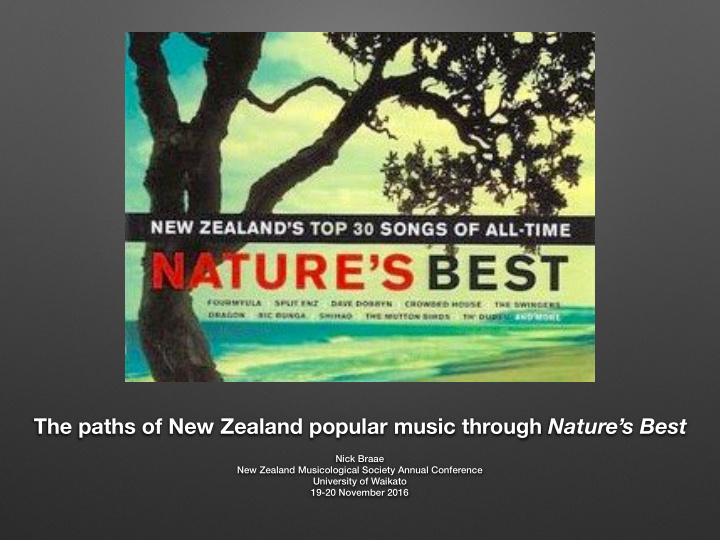



The paths of New Zealand popular music through Nature’s Best Nick Braae New Zealand Musicological Society Annual Conference University of Waikato 19-20 November 2016
Studying New Zealand Popular Music • Growth in the field— Many Voices (Johnson 2010); Home, Land & Sea (Keam and Mitchell 2011); Dunedin Soundings (Bendrups and Downes 2011) • Purposes of analysis—so what? (Moore 2009) • Issues of stylistic originality and derivation (Lealand 1988; Shuker and Pickering 1994; Shuker 2003/04, 2008; Zuberi 2007; Mitchell 2009; Cattermole 2011; Meehan 2011)— question of ‘whether or not’? • Implicit value judgements: ‘original’ fusions better than ‘derivative’ copies
Adjusting the Analytical Framework • What styles and sounds are employed by New Zealand popular music artists? • Where do these sounds come from? • How are the sounds and styles treated? • Why do some sounds appear and not others?
Analytical Scope and Methodology • 100 songs from three Nature’s Best albums (2002, 2002, 2003); New Zealand’s ‘Top 100 Songs of All Time’; equivalent of the Rolling Stone ‘Top 500 Songs’ list • A ‘mainstream’ and ‘critical’ canon of New Zealand popular music (Kärjä 2006); a representation of New Zealand recording industry 1970 - 2000 • Useful to analyse the sounds in New Zealand popular music over time; as well as understanding how cultural themes may be echoed in popular music • Style analysis of each song in the corpus • Individual descriptions of instrumentation and texture, harmonic language, drum groove, vocal techniques, form, production techniques; plus up to three additional traits • Up to five related examples from wider popular music repertoire to identify the respective musical ‘worlds’ of the Nature’s Best songs (Covach 1994, 2003)
Style Analysis of Fourmyula’s ‘Nature’ (1969) Four-track production Straight groove Verse-Chorus form Acoustic Modal harmonic Section-ending high instrumentation; language vocal harmonies ‘natural’ percussion Unembellished vocal tone 1960s folk rock with ‘baroque’ ‘Nature’ pop influences The Beatles’ ’The The Turtles’ ‘Happy Simon and Garfunkel’s The Beatles’ ‘While My Continuing Story of Together’ ‘Sound of Silence’ Guitar Gently Weeps’ Bungalow Bill’
The 1970s Generation • The ‘classic’ artists of New Zealand music: Dave Dobbyn, Neil Finn, Tim Finn, Don McGlashan, Jordan Luck, Hello Sailor, Dragon; contributed 34 of 100 songs to Nature’s Best • Bannister (2006): ‘austere’ and ‘formalist’ approach to songwriting—verse-chorus forms, conventional harmonic language, simple and catchy chorus melodies, basic rock band instrumentation
The 1970s Generation (contd.) • Bannister (2006): ‘circumscribed’ range of ‘white, masculine musical influences’ • Local settler culture sought to ‘repress and avoid references to foreign ideas and traditions’ • Hello Sailor’s ‘Blue Lady’ (1977) • Driving riff, guitar-based texture, harmonic loops, à la Peter Frampton, Little River Band, Graham Bonnet, Rolling Stones (i.e. ‘mainstream’ 1970s rock) • Absence of ‘foreign’ styles (e.g. blues, hard rock, West coast vocal harmonies) • Stylistically ‘plain’ rock music: influences from single sources within a narrow segment of popular music landscape (post-punk, pub rock, new wave); continuing work in the 1990s strips away influences
The 1990s Generation • Pop foundations of songs (verse-chorus forms, ‘clean’ production) • Stylistic diversity within tracks and across the musical landscape
Bic Runga’s ‘Suddenly Strange’ (1997) Texture and instrumentation - acoustic guitar, ‘shimmering’ electric guitar, string section, Vocal stylings - slight lean on bass guitar, drums consonant sounds 1990s female singer- songwriter (Lisa Loeb - Björk - ‘Army of Me’ ‘Falling in Love’) Pulsing mellotron The Beatles’ ‘Strawberry Fields Forever’ Harmonic language (descending bass lines)
Stylistic Variation in the 1990s Shihad - ‘Bitter’ (1995) Supergroove - ‘Can’t Get Enough’ (1994) Funk-Rock (Lenny Metal (Faith No More - Kravitz - ‘Always on the ‘What a Day’) Run’) Strawpeople - ‘Sweet Disorder’ (1994) Greg Johnson - ‘Liberty’ (1997) Trip-hop (Portishead - ‘Roads’) Britpop (Blur - ‘She’s So High’)
Stylistic Homogeneity to Heterogeneity? • Indicative of wider popular music trends: the 1960s ‘revival’ in the 1990s (Moore 2012) • Weakening of New Zealand settler identity post-Springbok protests (1981) and anti-nuclear protests (1980s) • Dave McCartney (Hello Sailor): ‘New Zealanders had a fear of being bold’ (interview with author, 2011); cf. 1990s view of borrowing freely (interviews with Sean Sturm and Julia Deans, 2011) • Historical narrative of popular music growth and expansion in New Zealand (e.g. John Dix’ Stranded in Paradise (1988, 2005); David Eagleton’s Ready to Fly: the Story of New Zealand Rock (2003))
Post- Nature’s Best • More Nature (2005) • Continuing the twin canons—mainstream pop-rock (Dobbyn, Finn Brothers, the feelers); Pacific hip-hop, reggae, metal (Nesian Mystik, Katchafire, Elemeno P) • Top-selling local singles 2010-2015: strong presence of pop-R & B (Stan Walker, J Williams), electronic pop (Lorde, Broods) and reggae (Six60)
Recommend
More recommend